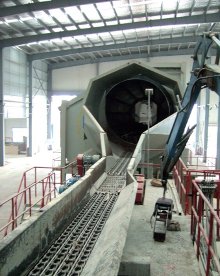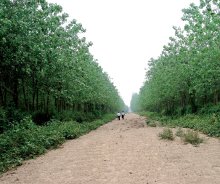Rest of world still grows
13 August 2012MDF capacity outside Europe and North America has shown a further increase, with more new mills in the pipeline for South America and Asia. In this second and final part of our survey of 2011, we look at the changes and the prospects for the industry in the coming years
Following on from our survey of the industry in Europe and North America (WBPI issue 3, 2012), we now focus on the existing MDF mills in the 'Rest of the World' as at end-2011 and on those under construction, or planning, for 2012 and beyond.
Our survey of Europe and North America showed very little activity, and no growth in western Europe or North America, but some growth in eastern Europe and Turkey. For 2012, we showed a growth of 1,210,000m3, or 5.9%, and for 2013 and beyond, a further 1,350,000m3, or plus 6.2% over 2012.
By contrast, for the Rest of the World, we show an increase of 6,495,000m3, or ca11.55% by end-2012 over end-2011, and another increase of 2,130,000m3, or ca3.4% for 2013 and beyond, although this includes no increase of which we are aware for China, which is probably unlikely.
That suggests an aggregate total of 56,244,000m3 capacity for the Rest of the World for end-2011 (54,592,000m3 in 2010) compared to the combined total of 25,320,000m3 (25,237,000m3) for Europe and North America. This shows that the 'old MDF world' is still shrinking slightly in its share of global capacity and now stands at around 45% (2010: 46.2%).
It should however be borne in mind that, with the difficulty in obtaining totally accurate information on the Chinese capacity, including all the small mills, we have had to make some informed assumptions for that country. As reported in the 2010 survey (of 2009), we were advised of an additional 10.4 million m3 of mills which we had not previously recorded. As the source was reliable, we have continued to include an extra 10.4 million m3 of capacity in our figure for China.
Accurately verifiable information on Chinese capacity is always welcome.
Developments in China
In last year's survey we said that China's construction industry appeared to be supporting the rest of the world's economies and that any fall in that demand could have serious consequences for everybody.
During 2011 and into this year we have seen the Chinese government get serious about slowing down the nation's spectacular economic growth and curbing its housing boom as part of that policy, to reign in inflation.
Bernard Fuller reported in his review of the Chinese economy that inflation did fall towards the end of 2011 and that housing construction activity did contract. He also suggested that there might not be much improvement in the economy before the second half of this year.
Obviously, a slow housing market means a slow panel market. However, it is undeniable that a lot more housing is required in China, so panel demand is expected to increase again before long.
Meanwhile, Bernard Fuller pointed out that Chinese MDF exports reached record levels in 2011, at 3.5 million m3.
Mike Botting's visits to several panel mills in China in March of this year also produced the impression that markets were getting tighter and that MDF capacity is perhaps getting too high, relative to demand.
Consequently, there is a growing interest in particleboard production, although it has to be said that we have been here before in recent years, but it was soon followed by a return to building MDF capacity. It will be interesting to see whether the Chinese will indeed accept particleboard, given their strong preference to date for MDF.
China will add 610,000m3 of MDF capacity in imported (Dieffenbacher and Siempelkamp) lines during 2012 and 3,825,000m3 in SWPM-supplied lines alone.
As we went to press, we received information kindly given by Shanghai Wood Based Panel Machinery (SWPM) concerning multi-opening and continuous lines it has supplied and which are due to start production in China in 2011/12. We have assumed that most of that volume will fall into 2012.
We did not have time to consolidate these into the listings or the space in this issue to list all 32 multi-opening lines.
Instead, we show the total in the 'summary of new capacity' table and a separate table listing just the continuous lines, until next year.
Developments in South America
During 2012, Argentina, Brazil and Colombia combined will add around 722,000m3 to that region's capacity.
In 2013 and beyond, Brazil seems set to add around a further 2,130,000m3, with two projects - 1,200,000m3 for Duratex and 180,000m3 for new industry player Placas do Brasil - both due in 2015, assuming neither company has second thoughts about what market there might be for these increased capacities.
Bear in mind that Berneck has already started up a 500,000m3 line in Brazil in March this year, following delays caused by the local electricity supply company.
There has also been corporate activity of a different kind in South America, with takeovers and mergers.
Arauco made a major move outside its home region when it announced on June 8 this year that it had bought all outstanding Flakeboard shares.
For Arauco, the purchase agreement would combine Flakeboard's five North American MDF operating facilities with that of Arauco's recently acquired particleboard and MDF plant in Moncure, North Carolina.
This will give Arauco a total global capacity in MDF of around 3.1 million m3.
The two companies are targeting a closing date during the second half of 2012.
Meanwhile, also in June, it was announced that Ecuadorian panel making group Cotopaxi had come to the rescue of Uruguayan plywood and MDF producer Urupanel (annual capacity 77,000m3), which was struggling with debt.
In another, partial, takeover, June also saw the announcement that Brazilian firm Duratex plans to acquire around 46% of the shares in Colombian wood based materials manufacturer Tablemac in a phased purchase over the next two years.
Tablemac started up Colombia's first MDF line earlier this year.
Developments in SE Asia
In South East Asia, Indonesia has two new lines coming onstream this year - one in the north of Sumatera and the other in the south. PT Sumatera Prima Fibreboard's line came on stream late last year in the north, while PT Indonesia Fibreboard Industry's (formerly known as ATR) line started up early this year in the south of the island.
In Thailand, Panel Plus at Hat Yai produced its first MDF board in April this year, and Rayong MDF in Rayong also started up around that time.
There is also a rumour of another company building an MDF line in Thailand but we have not been able to identify this project. Any information welcome, as always!
Meanwhile in Vietnam, tipped by many as one of the next 'hot spots' for new panel capacity, Korean firm Dongwha has started its 360,000m3 per year line this year.
We also believe there to be another line being built by Gai Lai MDF Vinafor (formerly Midland MDF) but we have not been able to obtain any information on this line.
One mill managing director in SE Asia reports that the outlook is not good for business in the region in the short to medium term, with markets in India, China and, to some extent, SE Asia in decline.
"The only market booming is the Middle East and we will see a big imbalance between supply and demand," he said, adding that the outlook for particleboard was even worse.
World Summary
The table showing aggregate world capacity lists the capacities in the various regions of the world from 2010 to '2013+'; the '+' denotes that some of this capacity is not anticipated to come onstream until 2015, as previously mentioned.
So we see that capacity for Australia/New Zealand continues to be static for the foreseeable future.
China's capacity has continued its inexorable rise from 37,340,000m3 in 2010 to a forecast 42,234,000m3 in 2012 and beyond.
South East Asia goes from 4,785,000m3 in 2010 to 6,123,000m3 in the same period - an increase of 1,338,000 - while North East Asia is forecast to remain unchanged.
Meanwhile, South America is set to increase its capacity from 6,527,000m3 in 2010 to 9,484,000m3 in 2013 - a significant increase of over 2.9 million m3.
As previously stated, western Europe and North America are at best stagnant, with the growth in Europe coming only from the eastern region.
Our final aggregate total for global MDF capacity at the end of 2011 is 81,564,000m3 and it looks set to reach around 87,761,000m3 by the end of 2012.
At the end of 2011, the Rest of the World possessed ca55% of global MDF capacity (2010 54%).
How the Listing was Compiled
The WBPI listings from 2010 were reviewed, and modifications made, using other published sources and data received directly from the mills.
Published information was reviewed for news of capacity changes.
These sources included relevant trade magazines, association reports and equipment suppliers' reference lists.
Self-completion enquiry forms were distributed to the mills in both Europe and North America, requesting current and future capacity data. Other questions were asked about non-standard production, future production rates, price movements and cost changes. The form was also posted on a special website.
The mills' own reported capacities are used wherever possible because this is the basis on which they make their estimates of future capacity and production changes.
Where this information is not available, published sources are used, usually on the basis of 330 operating days per year.
Conversion of ft2 to m3/year is made with 1,000ft3 equal to 1.77m3.

